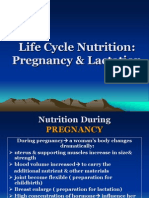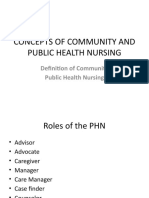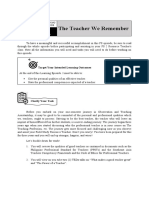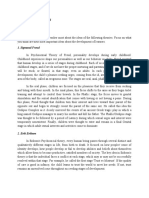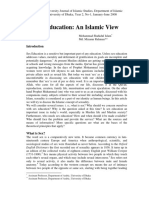3 Family Nursing Care Process
3 Family Nursing Care Process
Uploaded by
Kenn NuydaCopyright:
Available Formats
3 Family Nursing Care Process
3 Family Nursing Care Process
Uploaded by
Kenn NuydaOriginal Description:
Copyright
Available Formats
Share this document
Did you find this document useful?
Is this content inappropriate?
Copyright:
Available Formats
3 Family Nursing Care Process
3 Family Nursing Care Process
Uploaded by
Kenn NuydaCopyright:
Available Formats
FAMILY HEALTH NURSING
PROCESS
A. Concept of Family
B. Types of Family
C. Stages of Family Development
D. Roles and Responsibility of Family Members
E. Rights of Family
Family
Group of
people
(marriage,
blood,
adoption)
Social unit
Health unit
Human
system
Dynamic Process of Family
Procreation
Nurture
each
member
Social
Interaction
Maintain
stability
Morphostasis
The ability of the family system to
maintain consistency and stability
in its organizational
characteristics despite the
challenges that may arise over
time.
Morphogenesis
Ability to grow systematically over
time to adapt to the changing
needs of the family.
CONCEPTS
OF A
FAMILY
Individual
in family
context
Sum total
of
individuals
Biosocial
being
Equipotentiality
equal in the beginning
Things with the same original conditions can
go different ways
Members of the same family system can
share a very similar upbringing but turn out to
be very unlike each other.
Equifinality
equal in the end
Things with different original conditions can
turn out the same.
It is the ability of the family to achieve the
same goals through different routes.
Implications to the Nursing
Practitioner (PHN)
1. Understand the philosophy and family
dynamics, roles and influence in the
individual patients home care
2. Consider the external environment
3. Promotion and protection, prevention of
illness
4. Consider the family as a vital unit for
development, peace and health of the
society
Level of System by Smith and
Maurer
Society
Community
Family
Individual
Gene
Approaches to the Study of
Family Hill and Hansen
Approach Definition
INTERACTION APPROACH Knowing the internal structure
STRUCTURE FUNCTION APPROACH Knowing the family as a social unit
with hierarchy and role differentiaion
SITUATION APPROACH Knowing the base in behavior as
purposive in relation to the situation
INSTITUTIONAL APPROACH Understands the social unit of the
family (cultural values)
DEVELOPMENTAL APPROACH Focuses on the developmental phases
of the famly
FUNCTIONS OF FAMILY
A. Organization
B. Boundary
C. Differentiation
D. Territoriality
A. Organization
1) Reproduction or replacement
2) Physiological function
3) Socialization function
4) Status provider
5) Social controller
6) Other functions economic, educational,
recreational, religious, political
B. BOUNDARY
Rules that regulate (father) : Philippines
Must be changed depending on or according
to level of maturity and responsibility,
situation
Problem: Confusion and Frustration
dysfunctional family
Give children sense of responsibility, security
and stability.
C. DIFFERENTIATION
Depend on the family size, values and rules.
Division of labor
D. TERRITORIALITY
Expression of dominant behavior or territory of
belongingness, affection, cohesion, bonding and
other spatial and behavioral patterns between
and among family members
FAMILY HEALTH CARE STAGES
AND DEVELOPMENT TASKS
Stage Tasks
Beginning Family Estab. Satisfying marriage, to have or not to have
children?
Child bearing
Birth 30 mos.
Having/adjusting to infant, supporting the needs of 3
members, regenerating marital relationship
Family Preschool
Eldest 2 - 5 y/o
Adjusting to costs, adapting to needs & simulated
G&D, coping w/ parental loss of energy/privacy
Family SAC
6 12 y/o
Adjusting to the activity of growing children, promote
joint decisions b/w children & parents,
encourage/support childrens educ
Family Teenagers & Y A
13 20 y/o
Monitor open comm, support ethical & moral values,
balancing freedom & responsibility, releasing YA with
appropriate ritual and assistance, marital rel.
strengthened
Post Parental Prepare for retirement, maintain ties w/ older and
younger gen.
Aging Family Adjust to retirement, loss of spouse
9/14/2014 18
FILIPINO FAMILY DYNAMICS
i. DESCENT
ii. RESIDENCE
iii. AUTHORITY
iv. COMPOSITION
i. DESCENT
A) Patrilineal belonging to fathers lineage, use
of fathers surname
B) Matrilineal - belonging to mothers lineage
ii. RESIDENCE
1) Patrilocal
2) Matrilocal
3) Neolocal a
4) Avuncolocal
5) Bilocal
iii. AUTHORITY
1) Patriarchal
2) Matriarchal
3) equalitarian
iv. COMPOSITION
PROPERTY RELATIONS - Conjugal, separated
AFFINITY OR BLOOD RELATIONS conjugal
and consanguine
NUMBER OF MARRIAGES mono/polygamy
You might also like
- Community Public Health Nursing Promoting The Health of Populations 7Th Edition Mary A Nies Full ChapterDocument67 pagesCommunity Public Health Nursing Promoting The Health of Populations 7Th Edition Mary A Nies Full Chaptermargaret.perez647100% (1)
- Module 4a NCM 114Document84 pagesModule 4a NCM 114SONZA JENNEFERNo ratings yet
- Family Health Nursing Care ProcessDocument2 pagesFamily Health Nursing Care ProcessAnnalisa TellesNo ratings yet
- Module 3 Family Nursing Care PlanDocument16 pagesModule 3 Family Nursing Care PlanJam Dio Jubille PamogasNo ratings yet
- Carmel Marie Venezuela - Nursing Process in The Care of Population Groups and Community ActivityDocument5 pagesCarmel Marie Venezuela - Nursing Process in The Care of Population Groups and Community ActivityCarmel Venezuela100% (1)
- Formulation of Family Nursing Care PlanDocument12 pagesFormulation of Family Nursing Care PlanAndrea AputenNo ratings yet
- Health Educ Planning and Conducting ClassesDocument25 pagesHealth Educ Planning and Conducting ClassesKenn NuydaNo ratings yet
- Ds Relationship MaintenanceDocument3 pagesDs Relationship MaintenanceKing Karvo100% (3)
- College of Nursing Module 9: Family As A Client: Theories and Concepts Overview of The ModuleDocument14 pagesCollege of Nursing Module 9: Family As A Client: Theories and Concepts Overview of The ModuleMarthy BollenaNo ratings yet
- BFHI Revised Section2.4.a SlidesDocument92 pagesBFHI Revised Section2.4.a SlidesValencius Sunandar100% (1)
- The Family Health Nursing ProcessDocument25 pagesThe Family Health Nursing ProcessLovely OxemerNo ratings yet
- Community Health Nursing 1 Public Health Nursing in The PhilippinesDocument16 pagesCommunity Health Nursing 1 Public Health Nursing in The PhilippinesFlourence ZafranNo ratings yet
- Family Health 2Document42 pagesFamily Health 2coosa liquorsNo ratings yet
- CHN 1 Family Nursing ProcessDocument63 pagesCHN 1 Family Nursing ProcessMark FernandezNo ratings yet
- Family Health Nursing ProcessDocument9 pagesFamily Health Nursing ProcessLuis WashingtonNo ratings yet
- Life Cycle NutritionDocument63 pagesLife Cycle Nutritionmarisasuko100% (1)
- The Childbearing Childbearing Family in The Community MCNDocument9 pagesThe Childbearing Childbearing Family in The Community MCNAndrea Marie Sevilla0% (1)
- Community DiagnosisDocument184 pagesCommunity Diagnosisstephanie valerioNo ratings yet
- Dona 1 CmcaDocument29 pagesDona 1 CmcaKyra MercadoNo ratings yet
- Theorist Theory ConceptDocument5 pagesTheorist Theory ConceptjisooNo ratings yet
- Presentation By: MR - Kunal Jejurkar. (First Year, Msc. Nursing.)Document49 pagesPresentation By: MR - Kunal Jejurkar. (First Year, Msc. Nursing.)michaela100% (2)
- Levels of PreventionDocument3 pagesLevels of PreventionJustJ ThingsNo ratings yet
- Concept of Family HealthDocument15 pagesConcept of Family Healthheppy100% (2)
- Community Health Nursing I (Individual and Family) : Prepared By: Mrs. Lavinia T. Malabuyoc, MAN, R.NDocument48 pagesCommunity Health Nursing I (Individual and Family) : Prepared By: Mrs. Lavinia T. Malabuyoc, MAN, R.NLerma Pagcaliwangan100% (1)
- Decent 2ndDocument39 pagesDecent 2ndAnaliza Dumangeng GuimminNo ratings yet
- Family HealthDocument23 pagesFamily HealthHassan Kafi AliNo ratings yet
- Planning and Intervention in Intrapartum CareDocument5 pagesPlanning and Intervention in Intrapartum CareAngela MariaNo ratings yet
- Clinical RubricDocument5 pagesClinical RubricDani PhilipNo ratings yet
- Care of Mother and The Fetus During The Perinatal PeriodDocument30 pagesCare of Mother and The Fetus During The Perinatal PeriodPinsoy, Bruce riano e.No ratings yet
- Chapter 2 Family Centered Community Based CareDocument2 pagesChapter 2 Family Centered Community Based CareBlake McCabeNo ratings yet
- Family Nursing Process Family Nursing ContactsDocument7 pagesFamily Nursing Process Family Nursing ContactsPauline AlcantaraNo ratings yet
- Infant and Young Child Feeding ProgramDocument6 pagesInfant and Young Child Feeding ProgramYsabella AlcaldeNo ratings yet
- DUVALL'S FAMILY THEORY in NursingDocument19 pagesDUVALL'S FAMILY THEORY in Nursingoluwasujim100% (1)
- CHNDocument120 pagesCHNFaris CruzNo ratings yet
- Module 1 Lesson 1 m100Document8 pagesModule 1 Lesson 1 m100JunNo ratings yet
- 1-1-2 Framework For Maternal and Child Health NursingDocument3 pages1-1-2 Framework For Maternal and Child Health NursingKimberly CostalesNo ratings yet
- MCH StrategiesDocument26 pagesMCH StrategiesArRa Za (Arra)No ratings yet
- COPAR AssignmentDocument2 pagesCOPAR AssignmentAiron Vince Peralta CalicaNo ratings yet
- Concepts of Community and Public Health NursingDocument9 pagesConcepts of Community and Public Health NursingTheophilus BaidooNo ratings yet
- COPAR CP FormatDocument2 pagesCOPAR CP Formataya basilioNo ratings yet
- Notes - MCHN - Chapter 1Document12 pagesNotes - MCHN - Chapter 1Jamaica mitalNo ratings yet
- Lesson 1: Concepts of Community Health NursingDocument2 pagesLesson 1: Concepts of Community Health NursingClare Alcober100% (1)
- NCM 101 Course OutlineDocument6 pagesNCM 101 Course OutlineToni Angelie CaprechoNo ratings yet
- Module 2 Entrep in NSGDocument15 pagesModule 2 Entrep in NSGMarie Ashley CasiaNo ratings yet
- PT Family TeachingDocument2 pagesPT Family TeachingDenisia HoltNo ratings yet
- Determinants of Breastfeeding Mother's in Obio/AkporDocument16 pagesDeterminants of Breastfeeding Mother's in Obio/AkporNeat Script100% (1)
- Concept of Unitive and ProcreativeDocument27 pagesConcept of Unitive and ProcreativeKobs Foreigner100% (1)
- Family Data AnalysisDocument2 pagesFamily Data AnalysisFavila, Hazel, J. BSN-1C100% (1)
- Concept of Family Nursing Process Part 1Document14 pagesConcept of Family Nursing Process Part 1Fatima Ysabelle Marie RuizNo ratings yet
- Ethics in PediatricsDocument20 pagesEthics in PediatricsCruz YrNo ratings yet
- Theories Relevant To Nursing PracticeDocument61 pagesTheories Relevant To Nursing PracticeAngel BarrocaNo ratings yet
- Learning Objectives: Facilities:: NCM 102 Final Term Part I VideoDocument53 pagesLearning Objectives: Facilities:: NCM 102 Final Term Part I VideoAmber De la CernaNo ratings yet
- CHN NOTES Community 2Document16 pagesCHN NOTES Community 2kathleya100% (1)
- Culture Care Theory: By: Jennah Ercy S. de Leon, RNDocument18 pagesCulture Care Theory: By: Jennah Ercy S. de Leon, RNmaria cristina lugayNo ratings yet
- CHN IntroDocument6 pagesCHN IntroApril Elenor Juco0% (1)
- Maternal and Child Health Nursing: May Ann B. Allera, RNDocument16 pagesMaternal and Child Health Nursing: May Ann B. Allera, RNmayal100% (1)
- Chapter 14 Health EducationDocument42 pagesChapter 14 Health EducationNiwrad VlogsNo ratings yet
- Behaviour Change Communication AonDocument11 pagesBehaviour Change Communication Aonjoseph OngomaNo ratings yet
- Patient Rights & Organizational EthicsDocument17 pagesPatient Rights & Organizational EthicsBOnn EljayNo ratings yet
- Small Family NormDocument21 pagesSmall Family NormKailash NagarNo ratings yet
- Transcultural NursingDocument11 pagesTranscultural Nursingannu panchal100% (1)
- Nursing As A ProfessionDocument29 pagesNursing As A ProfessionKenn NuydaNo ratings yet
- Student Reporting Evaluation SheetDocument1 pageStudent Reporting Evaluation SheetKenn NuydaNo ratings yet
- Nursing TicsDocument25 pagesNursing TicsKenn NuydaNo ratings yet
- The Teacher We Remember: Target Your Intended Learning OutcomesDocument9 pagesThe Teacher We Remember: Target Your Intended Learning OutcomesKarah Shayne MarcosNo ratings yet
- LPDocument3 pagesLPJeffre AbarracosoNo ratings yet
- Ob 1-3Document45 pagesOb 1-3Mohammed MahgoubNo ratings yet
- Final Simple Research (BS CRIM. 1-ALPHA)Document5 pagesFinal Simple Research (BS CRIM. 1-ALPHA)Julius VeluntaNo ratings yet
- Assignment On DifferentiationDocument9 pagesAssignment On DifferentiationRuby Grewal Sharma0% (1)
- Non-Intellective Challenges in Oral Communication Skills Among Grade 11 LearnersDocument12 pagesNon-Intellective Challenges in Oral Communication Skills Among Grade 11 LearnersIJELS Research JournalNo ratings yet
- Motivational Needs Questionnaire 2009Document2 pagesMotivational Needs Questionnaire 2009galaxy113100% (1)
- Pamela M. Balagtas Beed 2E: 1. Sigmund FreudDocument3 pagesPamela M. Balagtas Beed 2E: 1. Sigmund FreudKennNo ratings yet
- Multiple Choice Questions On Oral CommunicationDocument10 pagesMultiple Choice Questions On Oral Communicationvirgie rey valenzuelaNo ratings yet
- Different Terminologies: Assessment, Testing, Measurement and EvaluationDocument12 pagesDifferent Terminologies: Assessment, Testing, Measurement and EvaluationAriel BobisNo ratings yet
- Sex Ed An Islamic ViewDocument19 pagesSex Ed An Islamic ViewEghar EverydayishellNo ratings yet
- Drug Education - G9Document48 pagesDrug Education - G9John Arvie TejanoNo ratings yet
- Edtpa Ele Literacy Assessment Commentary FinalDocument3 pagesEdtpa Ele Literacy Assessment Commentary Finalapi-270873656No ratings yet
- Freud's Personality StructureDocument36 pagesFreud's Personality StructureSara AliNo ratings yet
- Parent ConsentDocument16 pagesParent Consentdeborah matadosNo ratings yet
- Psychiatry Made EasyDocument14 pagesPsychiatry Made EasyD. W. S JayarathnaNo ratings yet
- Social Work Practicefroman Ecological PerspectiveDocument17 pagesSocial Work Practicefroman Ecological PerspectiveAnanta ChaliseNo ratings yet
- Panic Disorder and Agoraphobia: Randi E. Mccabe Martin M. AntonyDocument37 pagesPanic Disorder and Agoraphobia: Randi E. Mccabe Martin M. AntonyStephNo ratings yet
- The Psychological Impact of Incarceration ImplicatDocument18 pagesThe Psychological Impact of Incarceration ImplicatAlpha100% (1)
- "The Pursuit of Truth and Beauty Is A Sphere of Activity in Which We Are Permitted To Remain Children All Our Lives." - Albert EinsteinDocument11 pages"The Pursuit of Truth and Beauty Is A Sphere of Activity in Which We Are Permitted To Remain Children All Our Lives." - Albert EinsteinHaw TwanNo ratings yet
- The Importance of Mother Tongue Goes Far Beyond Being The First Language A Person LearnsDocument9 pagesThe Importance of Mother Tongue Goes Far Beyond Being The First Language A Person LearnsBhoomika Singh BhatiNo ratings yet
- Activity 2Document3 pagesActivity 2jakmensar01No ratings yet
- Childhood Trauma and AttachmentDocument17 pagesChildhood Trauma and AttachmentALNo ratings yet
- The Effects of Physical Movement Breaks Prior To Direct ReadingDocument36 pagesThe Effects of Physical Movement Breaks Prior To Direct Readingnanaaddod21No ratings yet
- A Report On A Business Leader Micheal deDocument21 pagesA Report On A Business Leader Micheal deAl Jazhim Khan MalikNo ratings yet
- Nitish @solutions UnlimitedDocument2 pagesNitish @solutions UnlimitedRevati Deepaksingh Rajput (Ms)No ratings yet
- RM-Topic 5-Classifcation of Nonverbal CommunicationDocument10 pagesRM-Topic 5-Classifcation of Nonverbal Communicationesmeraldoadelino95No ratings yet
- Nursing Leadership PhilosophyDocument8 pagesNursing Leadership Philosophyapi-449184986No ratings yet
- Various Strategies To Avoid COMM BREAKDOWNDocument14 pagesVarious Strategies To Avoid COMM BREAKDOWNSir yakopoNo ratings yet















